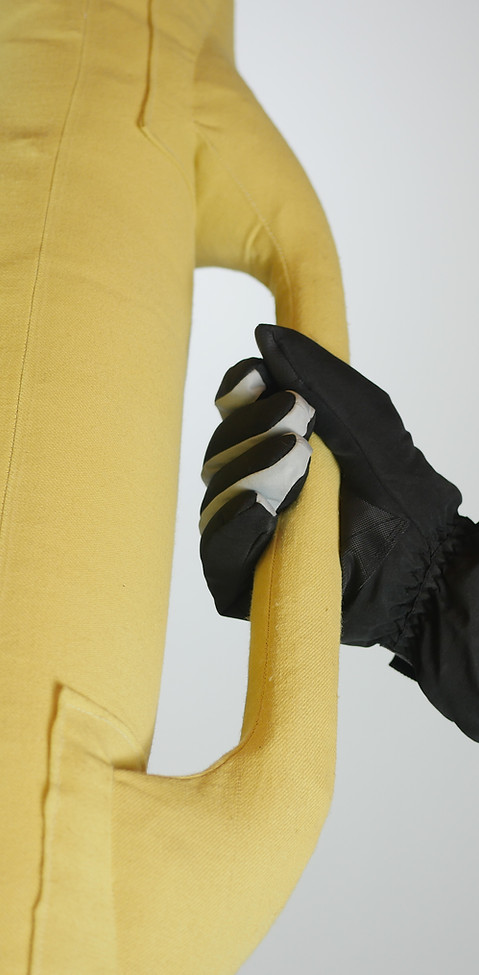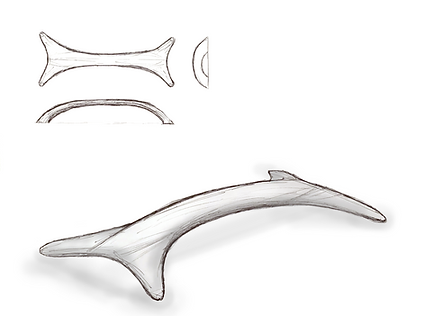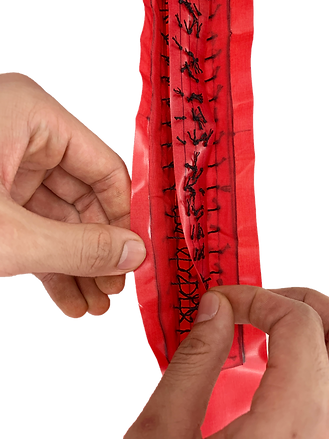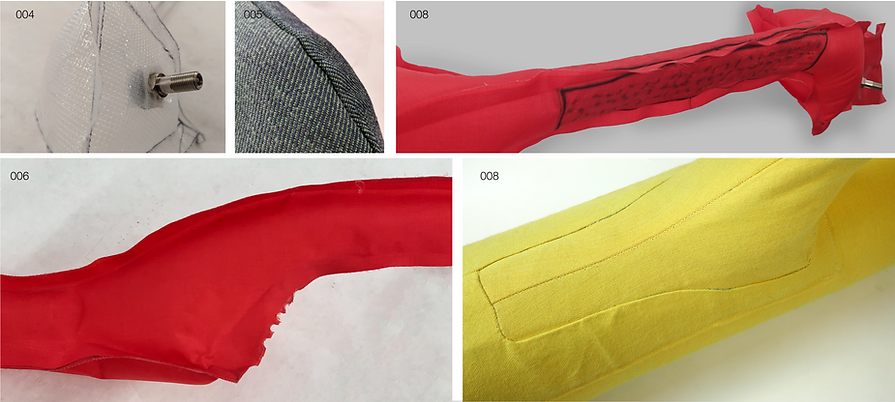
FOR INFLATABLE HABITAT

RIGIDIZED INFLATABLE HANDRAIL
WEARTECH X NASA
This design studio was part of a NASA challenge program. Throughout our design process, my teammates and I were in contact with our mentor Dr. Doug Litteken, a structural engineer at NASA.

Objective
PROBLEM
To design and create a handrail that will facilitate the astronauts movement for both inside and outside of an inflatable habitat.
The existing handrails on the International Space Station are metal, and therefore cannot be attached to an inflatable structure’s wall.
SYSTEM THINKING
In space, austronauts move around by using handrails. They use their upper body for most of the movement around the ship and their feet to ground themselves.
Our group decided on an inflatable opposed to a non-inflatable handrail because it is lightweight, can be easily packaged and deployed, and has a high compaction ratio—meaning that it has a greater volume to surface area.
Because the handrail must be attached to the inflatable airlock, we decided that it made the most sense to have the handrail also be an inflatable, because attaching fabric to fabric creates the most secure connection.

Inflatable Module
Inflatable Handrail
Connecting Tube


Air pump
Inflatable Handrail
We envisioned a modular system of attachment in order to eliminate post deployment set up time. The handrails would be attached to the interior and exterior of the inflatable airlock and inflate with a separate air pump once the airlock has been deployed. The connecting tubes would allow for continuous airflow through the line of handrails, even if an individual handle were to be damaged or fail.
FORM INSPIRATION
Once we had determined the profile shapes for extravehicular versus intravehicular use, we zoomed out and considered what the entire form of the handrail would look like. We drew our form instpiration from door, automobile and cane handles.

Door Handles
Automobile Handles
Cane Handles
When EVA gloves are donned, strength is reduced by nearly 50% and there is a considerable reduction in dexterity. My team and I started with ergonomic testing of handrail profiles with the glove donned in order to get an idea of the most secure shape to hold onto.
FORM IDEATION
Initial Ideation + Sketching
We began by sketching a wide variety of potential handrail forms, inspired by handles we encounter everyday in the world around us. We considered how the handrail would be attached to the inflatable airlock and explored single, double, and quadrouple handle mounting points. We decided to go with a handrail design that would be mounted to the inflatable airlock with two points because it would provide the astronauts with the largest surface area to grip onto.
Inflatable Profile with Drop Stitch
Inflatable Profile



ERGONOMIC STUDY 001
We selected 12 handle profile shapes, and performed multiple rounds of user testing for the specific needs of an extra-vehicular versus intra-vehicular handrail.
12 Handle Shape Profiles

ERGONOMIC STUDY 002
Which handle feels most secure to grab onto with a bare hand?
Which handle feels most secure to grab onto with a gloved hand?
Top 3 Handle Profiles

IVA
EVA
Testing

IVA

EVA
TRI-OVAL PROFILE
Analyzing Our Test Results
For Extravehicular Activity, 68% of our users chose Handrail shape K. 52% of users selected Handrail shape E for Intravehicular Activity.
Both selected profile shapes were tri-oval, which is a triangle with rounded corners. Through research and testing we found that the tri-oval shape fits most comfortably into the negative space of a gripping hand and that the flat underside of the handrail profile offered our users more security and comfort. When the first knuckle of the index finger overlaps with the thumb, grip strength is increased significantly. Due to the wearing of a simulated EVA glove, the overall diameter of the EVA handrail is smaller.




NEW CONSTRUCTION METHOD

Existing Technology
Exploded View
Interior Tension
Thread
Exterior of Inflatable
Paddle Board
Understanding Inflatables
The problem we encountered is that inflatables naturally want to be rounded, so we had to find a way to achieve the tri-oval profile that was most popular during our ergonomic testing, in an inflatable form. Through our research we discovered a construction method called drop stitching.


Inflatable Profile
Inflatable Profile
with Drop Stitch
Triple Drop Stich
We applied drop stitching to an inner layer of TPU backed Nylon and then fused it to an outer layer of TPU, which we then heat sealed. When inflated, this construction allowed us to maintain the tri-oval profile we desired.


Sketch

Profile
Outter Layer
Inner Layer
Drop Stitch
Exploded view

PROTOTYPE PROGRESSION


EVA + IVA TESTING
Even in our early testing, our prototype was able to support our classmate’s full bodyweight without rupturing. The model being tested here, is a heat sealed PVC/Nylon inflatable gut with a No-Stretch Canvas fabric overlay. Through testing, we learned about material failures versus the failure of our construction methods, such as heat sealing and stitching.
Handrail in Resting State

Handrail in Resting State

Pulling


After speaking to our mentor at NASA, Dr. Doug Litteken, we took his suggestion and used a stool on wheels to similate a microgravity environment in the testing of our prototypes. When fully inflated, the handrail can handle the forces of pulling and pushing from a user in a simulated microgravity condition. As seen in these documentation photos of our test procedure, there is only a slight bending in the inflatable handrail when pulling force is applied.

Torsion
The handrails also needed to account for the torsional force that an astronaut would apply to it in microgravity. As evidenced by photo and video documentation of our user testing, the handrail provides a sturdy twist point for the astronaut to maneuver his or her body around.


FINAL CONCLUSION
The handrail allows for the gloved and bare hand to grasp firmly, and the tri-oval profile aides the astronauts ability to obtain a strong grip. Since grip strength is decreased by 50% when an EVA glove is donned, we simulated this decrease in dexterity by layering 2 gardening gloves with a ski glove overlay in our testing.

IVA
EVA

THANK YOU
